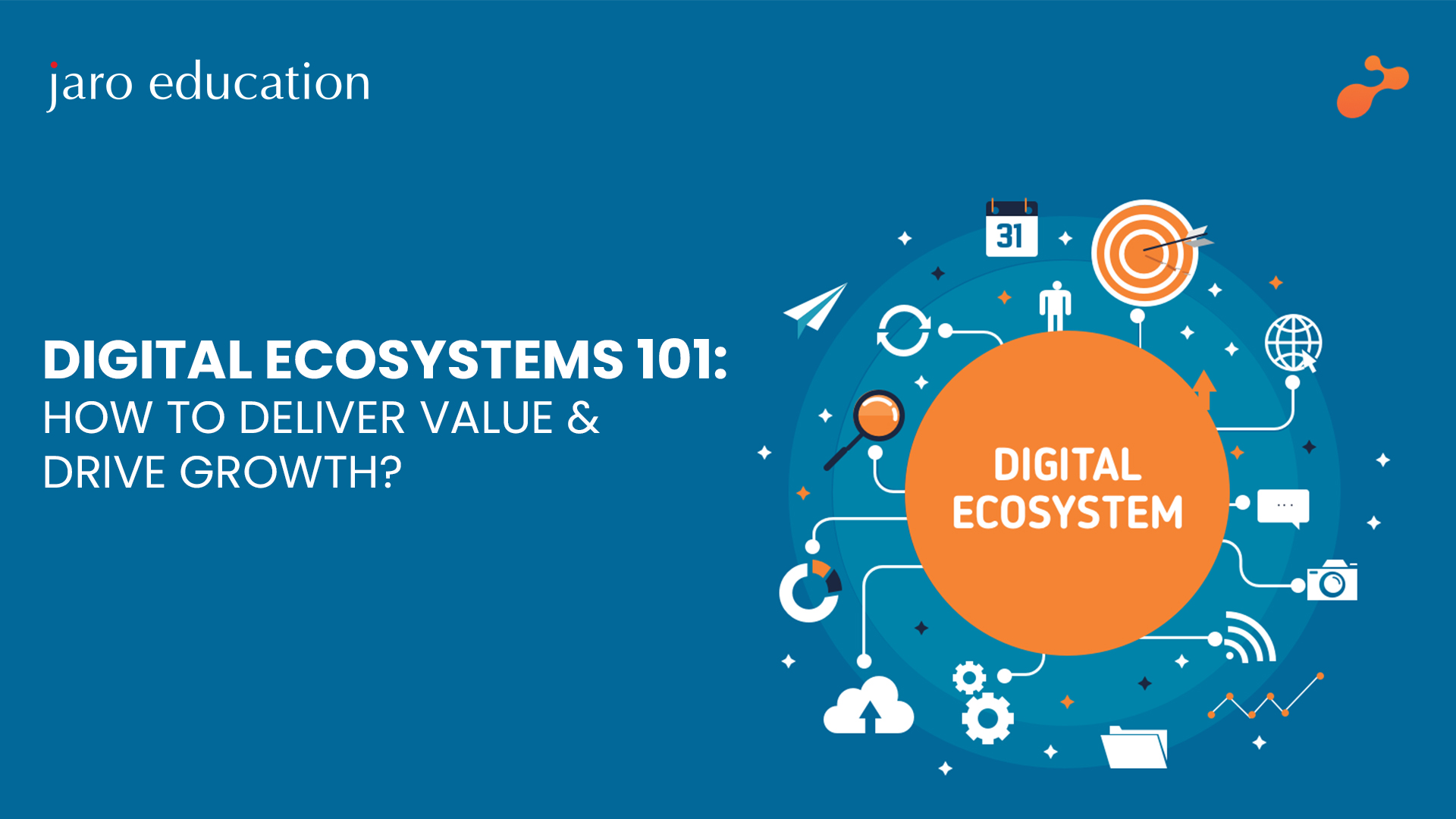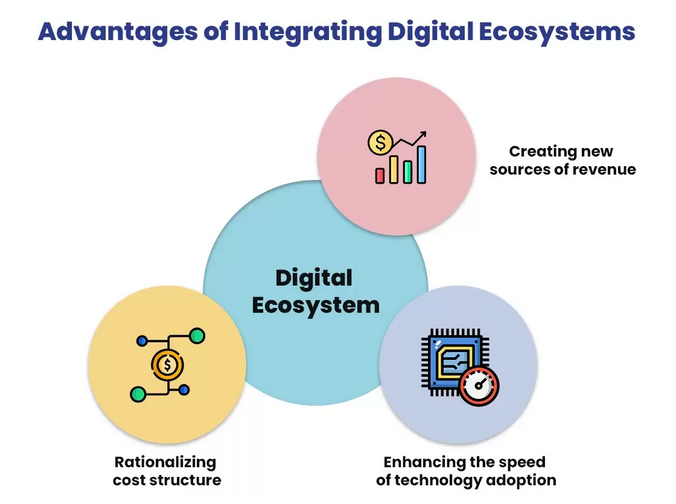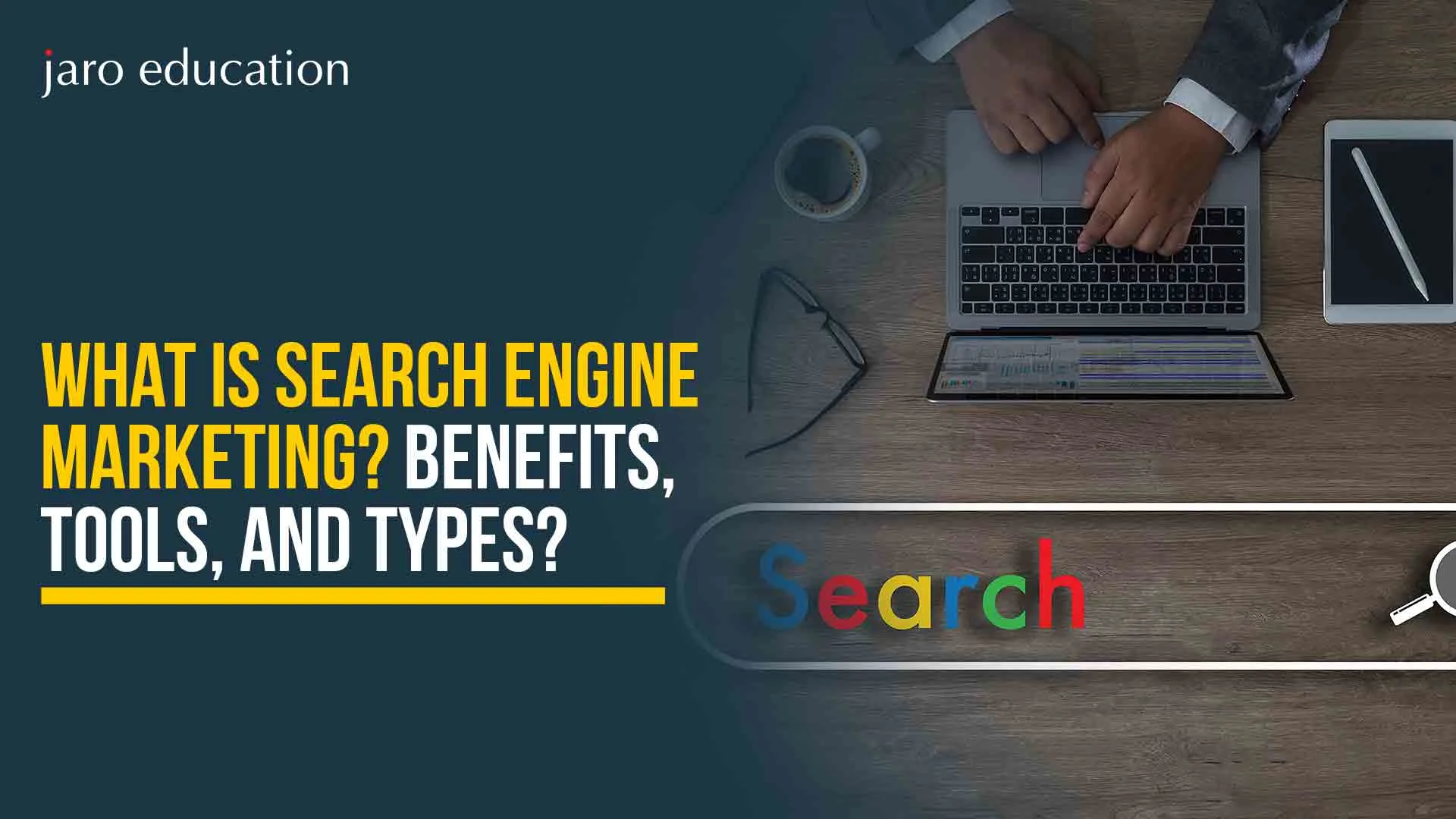Digital Ecosystems 101: How to Deliver Value & Drive Growth?
Table of Contents

- jaro education
- 1, April 2024
- 2:00 pm
In the B2B SaaS industry, there’s a growing focus on ecosystems. Customers prefer integrated solutions over traditional sales models. This shift towards valued products and services is prompting teams to rethink their strategies. Digital ecosystems, facilitated by the current digital landscape, emphasize mutually beneficial partnerships to maximize customer value. Creating such ecosystems is a strategic move for businesses seeking growth in today’s innovative era. Here’s how digital ecosystems can drive value and foster growth.
Benefits of Digital Ecosystems
A digital business ecosystem generates an abundance of advantages. As an organization leader, by using your partners and shared resources, your organization may improve agility, save expenses, and create new income streams. Here are a few more benefits of the digital business ecosystem you can witness.
New Revenue Streams are Built
As per Gartner; successful digital ecosystems witness higher growth and exponential profits than industry averages by 27% to 32%. But why is that happening? The main reason is data. When companies collaborate in a digital environment, the volume of data increases quickly. More data gives you more opportunities to understand your clients.
With data insights and pooled resources from your partners, you may provide value to your consumers by:
- Improving current products and services
- Accessing an untapped customer base
- Create new products and services (or new sources of money)
Pave the Way to Digital Transformation
For businesses, digital transformation is as necessary as breathing for human beings. If the internal tools and operations of your company are compromised or efficient, you avoid losing alliances, falling behind the market, and being unprepared for future upheavals. Thus, creating a digital ecosystem is an excellent strategy to start or continue digital transformation. It challenges firms to evaluate their current procedures, partners, and technological landscape.
Throughout the process, you may automate, experiment with AI, and update old systems. All efforts are worthwhile, whether you have a digital environment or not. These improvements will simplify operations, giving your organization more time to focus on innovation.
Remember that whatever improvements you make throughout your ongoing digital transformation will set the groundwork for a strong digital ecosystem.
Lowers the Operational Cost
This is where a company’s digital transformation efforts will truly pay off. Integrating digital technology into your company operations improves efficiency and lowers costs by:
- Automating manual tasks
- Reducing mistakes
- Optimizing workflows
Partnerships can help businesses reduce the cost of acquiring new customers. With partner data, you may reach a larger client base without spending a lot of money on marketing. Your partners may also add value to your clients, making your business more relevant.

*itechindia.co
What are the Elements of Digital Marketing Ecosystem?
In digital ecosystems, everyone is involved in growing and nurturing the company, like a giant team. Of course, there are different teams for different operations, but they all work together in a unified way, which builds harmony among employees and customers who also receive value-based products and services. This is exactly how a company’s brands, products and services are also promoted. But for that, it is important to design a solid campaign for which digital marketing is important.
Since the entire process of digital marketing (from creation and execution to implementing the feedback) is a vast process and it also requires to be done in a unified way, you can call it the “digital marketing ecosystem”. Here are the core elements of the digital marketing ecosystem.
Website
The website is be the most important component of the digital ecosystem since it is completely under your control. You may use any marketing approach you desire on your website to sell any product or service. You may also optimize it to increase conversion rates.
Brand
The brand helps customers and potential buyers recognize the products or services. It is the face of a company, so it should convey a clear message about what you provide and how you provide it. This part is critical since, without a brand, a website or marketing campaign cannot distinguish itself from the competition.
Objectives
In every sector, it is vital to set an attainable goal and draw out ways to achieve it. What should be your main focus as a business leader? To attract more customers? Or to increase your brand’s awareness? To prevent wasting important resources, clear goals must be established before developing any type of digital marketing campaign.
Digital Platforms
Digital platforms are pivotal elements of the digital marketing ecosystem since they help to increase a brand’s presence. Apart from the website- the primary channel, you can also use social media channels (Twitter and Facebook) and email networks to spread a positive word about your products and services.
Search Engine Optimisation (SEO)
The most powerful digital marketing technique to ever exist is Search Engine Optimisation. Many companies use this method to succeed in their online marketing efforts. SEO is basically a channel that helps businesses gain visits and, eventually, customers via search engines such as Google or Bing. Search Engine Optimisation is so successful because once you establish strong foundations via authority and content, your website will transform into a machine that automatically attracts qualified people.
Pay-per-click (PPC) Advertising
Using Yahoo, Facebook Ads and Google Adwords, you can achieve the most beneficial and unique advertising strategies, known as PPC, in which you only pay “when a user clicks on your ad,” which is a highly intriguing approach to generating leads. If you have the resources, integrating SEO and PPC may be quite beneficial to your organization. SEO focuses on the long term, whereas PPC focuses on the near term. If you use both of these techniques correctly, you may produce a significant amount of income on a continuous basis.
Web Analytics
Creating a digital marketing campaign is not enough. It is also important to track the effectiveness of it. For that, you can employ a set of advanced technology called web analytics. Web analytics is critical and must be understood correctly since these technologies provide adequate data to make informed business decisions, allowing your marketing plan to create greater outcomes over time. Google Trends, HubSpot, Google Search Console, Google Data Studio and Google Trends are among the most widely used online analytics solutions.
Content Marketing
To attract relevant customers to the website, it is essential to create, publish and distribute relevant content. And what’s a better technique than content marketing? It is a way of gently instilling a desire for your goods or service in your website visitors. Content marketing employs a variety of distribution methods to reach a large audience, including email newsletters, blogs, ebooks, social media publishing, infographics, films and so on.
Social Media Marketing
Social media marketing has become a great tool for spreading a brand or product to online communities beyond borders. However, brands must understand and determine their target demographic and the ideal social media channel for the product. These days, social media channels like Facebook, Instagram, LinkedIn, YouTube and Pinterest have become the focal points of digital marketing; they have proven to be great options for attracting interested visitors to websites or e-commerce platforms. Remember, social media marketing should always begin with developing material that appeals to our target audience and that they find fascinating and relevant to their requirements.
Email Marketing
The process of connecting with your target audience via email is referred to as email marketing. You may increase conversions significantly by developing an engaging email with information about your products and services. A solid and efficient email marketing plan must be implemented in a discreet manner that does not invade the client’s privacy. Companies may benefit from email marketing in a variety of ways, including building direct relationships with subscribers, communicating messages and information to various people and receiving feedback on their services, brands, or products.
How Does a Digital Ecosystem Work?
To drive a digital world, it is imperative to combine people and technology. Besides, the company’s role should be determined by its products and services. This environment should include the following generally defined business roles for orchestrators, who coordinate supply and demand and enable others to engage in the digital economy.
- Orchestrators coordinate supply and demand and enable others to engage in the digital economy.
- Producers are people who produce value through basic products or services aimed at consumers, businesses, buyers, and sellers.
- Consumers are individuals who benefit from the digital environment. Consumers can also become producers.
In terms of technology, managing an ecosystem and facilitating connectivity also requires:
- Knowledge management platforms
- Customer engagement and relationship management tools
- Social media channels
- Mobile apps
- Collaborative software
- Project management tools
What are the Different Types of Digital Ecosystems?
There are various types of digital ecosystems based on the number of partners and what they offer. Some of them are as follows:
Platform ecosystems provide a shared platform for all linked organizations to operate and collaborate on. For example, Salesforce and HubSpot.
In-house digital ecosystems are made up of a single firm that offers a variety of interconnected goods. Some good examples are Amazon Web Services and Amazon Music.
Functional digital ecosystems are the simplest model. They are specially designed to support a current product or service. For example, partnerships in the manufacturing supply chain are prevalent in the automobile business.
Superplatform ecosystems are the most refined model. They link platforms from numerous sectors, allowing for a wide range of consumer experiences. A virtual assistant is an excellent example since it combines shopping, transportation, communication and payment services.
Conclusion
A company, to increase its face value and goodwill for its products and services, should implement effective ways to build a robust digital ecosystem. You can bring your different teams together to improve, create new products/services, or partner with other companies to further your brand’s online presence. For that, you must have strong leadership skills to understand how to grow an online business, and to gain that; you must pursue the Chief Technology Officer Programme by CEP, IIT Delhi.
This is a 10-month program that will offer you insights into the digital domain so that you achieve relevant business skills. Since technology is the core of today’s business, this course will also help you gain a competitive tech edge in the organization. Enroll now and amplify your digital ecosystem knowledge.










